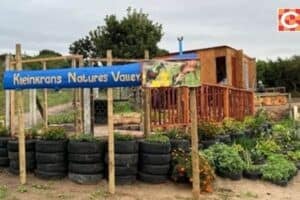Remembering the 2017 Knysna fires: SANParks looks at the extent of the damage the fires caused in national parks, Cape Nature properties and land/forests.

SANParks scientist Johan Baard worked out the initial percentage affected in Harkerville, near Knysna, immediately after the fire, and worked out the information below regarding areas affected by the Knysna fires last year.
According to SANParks spokesperson Nandi Mgwadlamba, the most affected part of the national park was in Harkerville, which is a hub for visitors, Knysna Plett Herald reports.
READ MORE: Knysna fires saw people working together
Progress of hiking trails in Knysna since the Knysna June wildfires:
Harkerville Trail
The trail was rerouted in December 2017 pending the recovery of the burnt area, but the coastal portion of the trail is still closed. An alternative scenic route was opened along the coastal ridge.
Bookings for the trail are open.
Kranshoek Trail
The Kranshoek Trail is still closed, and maintenance work is currently under way. About 90% of the route is complete, but rebuilding and rehabilitation of the route is under way.
Kranshoek Viewpoint
Currently still closed and not accessible to visitors as yet until management and scientists have finalised urgent deliverables pertaining to the area.
“When assessing the fire and storm that affected Garden Route, geographical information system [GIS] mapping plays a vital role in identifying high-risk areas in need of immediate rehabilitation. GIS technology is used to capture, analyse and present digital geographic data.
“However, environmental specialists do not only rely on GIS technology but also do site visits (ground truthing) to confirm GIS findings.
“High-risk areas include slope and threat to safety, downstream of catchments and ravines and human-made infrastructure. These areas are prioritised because of the immediate danger posed by erosion and mudslides. These included mainly places outside the park.”
According to Mgwadlamba, the following interventions were rolled out by the multi-agency Garden Route Rebuild intervention, which included SANParks’ input:
- Installing bio-sausages to slow water velocity, which will reduce sediment flow along steep slopes.
- Felling and scaling down of dead brush and trees.
- Monitoring of plant regeneration for invasive alien plant regrowth.

And so life goes on for the spoonbill. Photo: Supplied
The status quo now, says Mgwadlamba, is that there are areas that need to be rehabilitated first before rebuilding can begin.
“So the iconic Red Cycling Route was rerouted for now until some areas are rehabilitated and rebuilding can continue. This is also the case with the two-day Harkerville coastal hiking trail,” she says.

GIS map indicating the burnt area in the Park as compared to the total number of hectares in the Garden Route National Park. Photo: Supplied by SANParks.
“We also encourage landowners to get to eradicate alien invasive species (AIPs) on their own land or request assistance from the municipalities, SANParks biodiversity programmes and other organisations working to free land and water from the scourge of AIPs.
“Although we gave away indigenous trees to replant after the fires, most nurseries in the Garden Route have stock of indigenous plants and trees. Baard suggests the planting of trees and dune plant species effective for post-fire rehabilitation, as follows:
“Plant these trees: Podocarpus falcatus; Ekebergia capensis (essenhout); Virgilia divaricata (keurboom) – nitrogen fixing; Buddleia saligna and salvifolia; Burchellia bubaline (wild pomegranate); Celtis africana (white stinkwood); Diospyros lycioides subsp. guerkei (monkey plum); Halleria lucida (white olive); Kiggelaria africana (wild peach); Nuxia floribunda (forest elder) – bees; Pterocelastrus tricuspidatus (candlewood); Faurea saligna (boekenhout); Tarkananthus littoralis (camphor); Psoralea pinnata; Erica discolour subsp speciosa; Salvia africana-lutea; Leucadendron salignum; Leucospermum glabrum; Rhus chirindensis, lucida and crenata.
“Dune-specific plants: Asparagus zygophyllum; Carissa bispinosa; Colpoon compressum; Maytenus procumbens; Ehrata ramiosa (grass); Carpobrotus edulis (yellow flower) or deliciosus (pink flower).”
Restoration efforts will enhance post-fire recovery and see that rehabilitation includes short and long-term treatments, says Mgwadlamba.
Behind the scenes
- SANParks marine rangers helped transport residents with NSRI volunteers from Brenton to the jetty.
- Terrestrial rangers in Diepwalle who are used to fighting wildfires went to assist to extinguish structural fires.
- The planning division formed part of the joint operating committee from day one and also formed part of the ground-truthing exercise with the municipalities to determine the exact areas burnt. They also continued to play a key role in the Garden Route Rebuild structures.
For more news your way, follow The Citizen on Facebook and Twitter.






